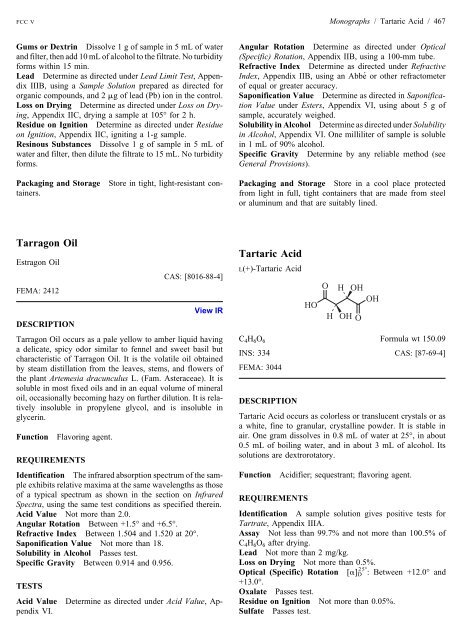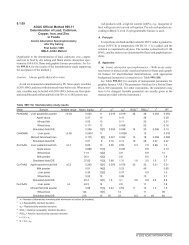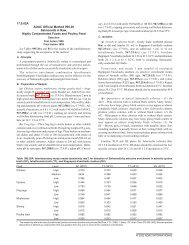Talc Tallow
Talc Tallow
Talc Tallow
You also want an ePaper? Increase the reach of your titles
YUMPU automatically turns print PDFs into web optimized ePapers that Google loves.
FCC V Monographs / Tartaric Acid / 467<br />
Gums or Dextrin Dissolve 1 g of sample in 5 mL of water<br />
and filter, then add 10 mL of alcohol to the filtrate. No turbidity<br />
forms within 15 min.<br />
Lead Determine as directed under Lead Limit Test, Appendix<br />
IIIB, using a Sample Solution prepared as directed for<br />
organic compounds, and 2 g of lead (Pb) ion in the control.<br />
Loss on Drying Determine as directed under Loss on Drying,<br />
Appendix IIC, drying a sample at 105° for 2 h.<br />
Residue on Ignition Determine as directed under Residue<br />
on Ignition, Appendix IIC, igniting a 1-g sample.<br />
Resinous Substances Dissolve 1gofsample in 5 mL of<br />
water and filter, then dilute the filtrate to 15 mL. No turbidity<br />
forms.<br />
Packaging and Storage Store in tight, light-resistant containers.<br />
Tarragon Oil<br />
Estragon Oil<br />
FEMA: 2412<br />
CAS: [8016-88-4]<br />
View IR<br />
DESCRIPTION<br />
Tarragon Oil occurs as a pale yellow to amber liquid having<br />
a delicate, spicy odor similar to fennel and sweet basil but<br />
characteristic of Tarragon Oil. It is the volatile oil obtained<br />
by steam distillation from the leaves, stems, and flowers of<br />
the plant Artemesia dracunculus L. (Fam. Asteraceae). It is<br />
soluble in most fixed oils and in an equal volume of mineral<br />
oil, occasionally becoming hazy on further dilution. It is relatively<br />
insoluble in propylene glycol, and is insoluble in<br />
glycerin.<br />
Function Flavoring agent.<br />
REQUIREMENTS<br />
Identification The infrared absorption spectrum of the sample<br />
exhibits relative maxima at the same wavelengths as those<br />
of a typical spectrum as shown in the section on Infrared<br />
Spectra, using the same test conditions as specified therein.<br />
Acid Value Not more than 2.0.<br />
Angular Rotation Between +1.5° and +6.5°.<br />
Refractive Index Between 1.504 and 1.520 at 20°.<br />
Saponification Value Not more than 18.<br />
Solubility in Alcohol Passes test.<br />
Specific Gravity Between 0.914 and 0.956.<br />
TESTS<br />
Acid Value Determine as directed under Acid Value, Appendix<br />
VI.<br />
Angular Rotation Determine as directed under Optical<br />
(Specific) Rotation, Appendix IIB, using a 100-mm tube.<br />
Refractive Index Determine as directed under Refractive<br />
Index, Appendix IIB, using an Abbé or other refractometer<br />
of equal or greater accuracy.<br />
Saponification Value Determine as directed in Saponification<br />
Value under Esters, Appendix VI, using about 5 g of<br />
sample, accurately weighed.<br />
Solubility in Alcohol Determine as directed under Solubility<br />
in Alcohol, Appendix VI. One milliliter of sample is soluble<br />
in 1 mL of 90% alcohol.<br />
Specific Gravity Determine by any reliable method (see<br />
General Provisions).<br />
Packaging and Storage Store in a cool place protected<br />
from light in full, tight containers that are made from steel<br />
or aluminum and that are suitably lined.<br />
Tartaric Acid<br />
L(+)-Tartaric Acid<br />
HO<br />
O<br />
H<br />
H<br />
OH<br />
OH<br />
OH O<br />
C4H6O6 Formula wt 150.09<br />
INS: 334 CAS: [87-69-4]<br />
FEMA: 3044<br />
DESCRIPTION<br />
Tartaric Acid occurs as colorless or translucent crystals or as<br />
a white, fine to granular, crystalline powder. It is stable in<br />
air. One gram dissolves in 0.8 mL of water at 25°, in about<br />
0.5 mL of boiling water, and in about 3 mL of alcohol. Its<br />
solutions are dextrorotatory.<br />
Function Acidifier; sequestrant; flavoring agent.<br />
REQUIREMENTS<br />
Identification A sample solution gives positive tests for<br />
Tartrate, Appendix IIIA.<br />
Assay Not less than 99.7% and not more than 100.5% of<br />
C4H6O6 after drying.<br />
Lead Not more than 2 mg/kg.<br />
Loss on Drying Not more than 0.5%.<br />
Optical (Specific) Rotation<br />
+13.0°.<br />
25°<br />
[] D : Between +12.0° and<br />
Oxalate Passes test.<br />
Residue on Ignition Not more than 0.05%.<br />
Sulfate Passes test.




